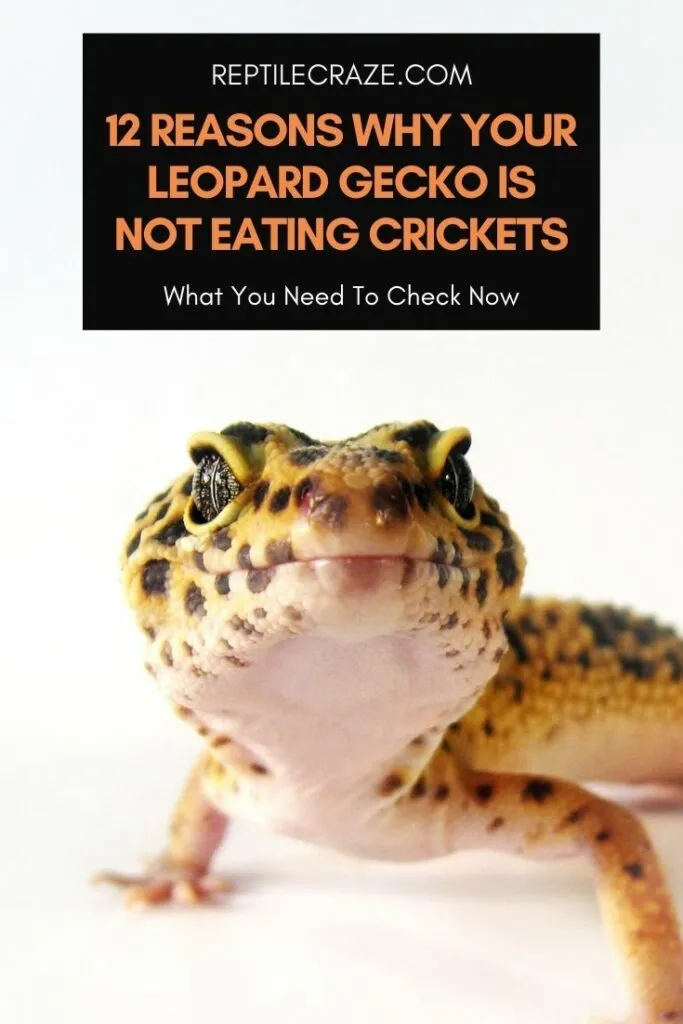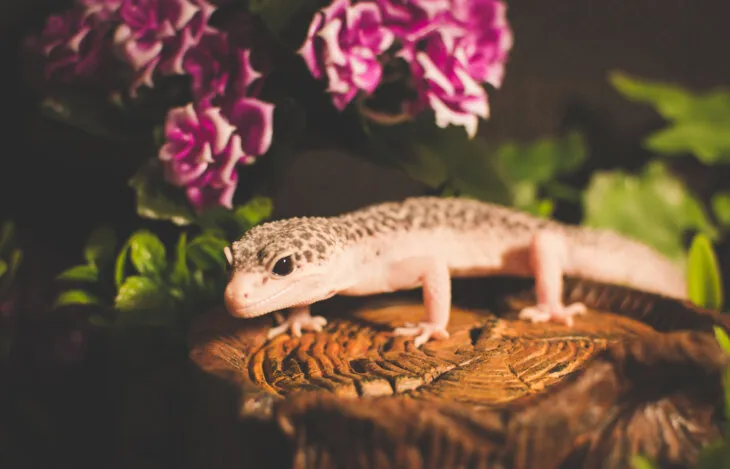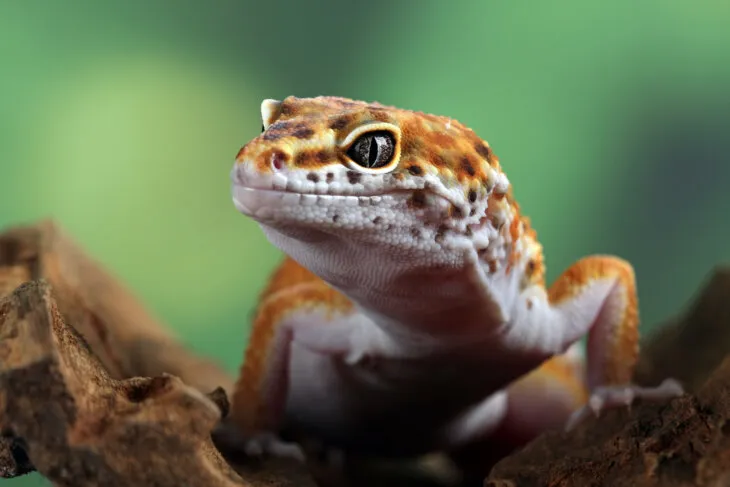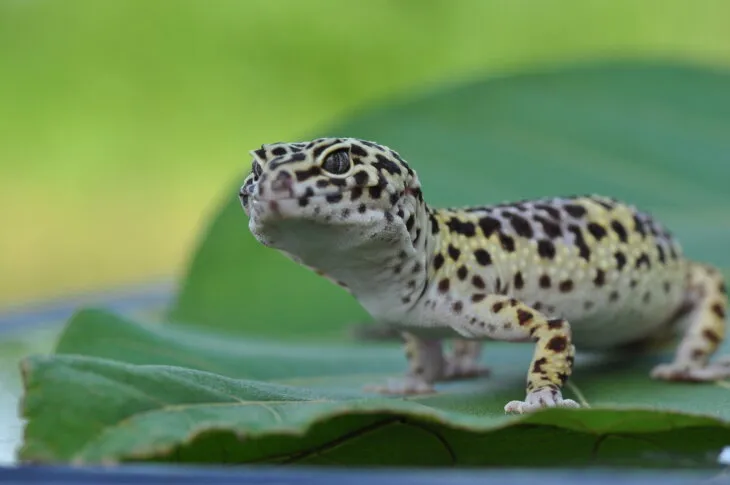
Leopard geckos are enthusiastic feeders that won’t feed on anything that doesn’t put up a fight. Since crickets are active insects, they’re a great diet that many geckos would hardly be able to resist. When your leo won’t eat crickets, there could be a problem. This article will help you find out possible reasons for the issue.
Your leopard gecko may refuse to eat crickets if there are cage issues, health issues, or cricket issues (too large or inactive). Your leopard gecko might also be addicted to other feeder insects. It is essential to analyze each of these factors, as they can occur concurrently or independently.
This article will give you an exhaustive analysis of the reasons your leopard gecko isn’t eating crickets. It will also give you some worthwhile tips on how to stimulate your gecko’s appetite for crickets.
Table of Contents
Feeding Issues
These are hitches related to the crickets, other insect feeders, and your leo’s general feeding habits.
Note: If your leopard gecko isn’t eating at all, you should read our article here. It shows you 21 reasons why your leo won’t eat.
Your Gecko Won’t Feed on Immobile Crickets
Leopard geckos are predators that prey on live insects in their natural environment. Your now captive leo won’t eat dried or dead crickets. You’ll need to mimic its natural diet by providing live and moving crickets.
If you’re apprehensive about your pet’s peace of mind, you can remove the crickets’ hind legs to keep them from hopping up high and make it easy for your gecko to catch them.
Tip: If you want to make your leopard gecko eat dead food, here is how to do that.
Your Leo Has Changed Its Taste Preferences
In the wild, geckos feed on a variety of insects. While some pet geckos will happily eat crickets forever, some owners report that their leos appear to get bored with a repetitive diet. In these cases, they usually regain their appetite when offered variation.
When fed on other insects, your leo may prefer their taste rather than crickets. Insects such as waxworms entice your pet’s taste buds, causing addiction. If your leopard gecko is addicted to waxworms, they may not accept any more crickets.
Feeder insects with a higher fat content such as waxworms and butter worms are fatty and addictive. To control your pet’s weight gain, you should give them rarely as treats and not as a regular diet.
We also explain here why crickets are one of the best staple feeder insects for leopard geckos. We highly recommend reading it as it also shows you how to feed them to your leo correctly.
The Crickets Are Too Big for Your Leo
If you provide big crickets, your leo will reject them. It is important to give crickets that are smaller than the space between your gecko’s eyes. Large crickets can cause impaction in your leo’s gut.
Generally, you should give ¼ inch crickets to a baby gecko, ⅜ inch crickets to a juvenile, and small adult crickets to an adult gecko.

You Have Given Excess Crickets
Your leo won’t eat more than its fill. Your baby leopard gecko can only eat 5-7 crickets per day while an adult eats 6-7 crickets on alternate days.
Habitat Issues
Your gecko may refuse to eat its crickets when the conditions in its habitat are not conducive.
Vivarium Temperatures and Lighting Are Too Low
Geckos require high temperatures to digest their
Scientists have discovered that geckos prefer temperatures between 86 °F and 95 °F (30 °C and 35 °C). You can consider this as the basking area temperature.
Provide a cool side/hiding area at 75-80 °F, and keep night temperatures between 65-74 °F. Never allow the temperatures to go below 65 °F as it would cause digestive problems and other illnesses.
Your gecko requires approximately 10-12 hours of daylight and 12-14 hours of nighttime. Your gecko needs to absorb enough light through its skin to synthesize vitamin D3.
Some people use low output UVB lighting in their leopard gecko tanks. The bulbs degrade with time, and you should replace them every six months. However, dietary vitamin D3 alone can satisfy a leopard gecko’s vitamin D requirements for growth.
The Vivarium’s Humidity Might be Lower than Required
Your leopard gecko won’t eat its crickets or other
Low humidity can cause problems when your leopard gecko is shedding its skin, and can cause your gecko to get dehydrated. Both of these will cause your leopard gecko to stop eating.
As well as monitoring and adjusting the humidity, it is essential to keep a bowl of clean water for your gecko to drink. You should change the water and disinfect the bowl regularly, since your leo may defecate in it.
Your Gecko’s Housing is Unfavorable
If your gecko refuses to eat crickets, check its housing. The housing should resemble its natural habitat to a large extent. Construct the vivarium with a larger surface area horizontally than vertically.
You should provide branches, plants, caves, logs, etc. to enrich your leo’s habitat.
Choose your substrate wisely: material like coarse sand can cause impactions if your leopard gecko eats it. Reptile carpet, reptile clay, slate floor, times, newspaper or paper towels are recommended.
When you transfer your leopard gecko to a new home, it may refuse to eat for a few days to a week.

Health Concerns
Underlying health issues can also cause your leo to avoid eating crickets or other foods.
Your Gecko Has Poor Eyesight
Vision impairment is a common problem in injured or aged leopard geckos. Temporary blindness may result from an incomplete shedding caused by low humidity.
Your leo can’t chase crickets in such a condition so you can feed it using tongs or give it slow-moving insects such as mealworms.
Your Leo Could be Suffering from Impaction
Impaction is a common condition in leopard geckos. It is a blockage of parts of the digestive tract caused by large foods or non-food materials swallowed by the leo.
An impacted leopard gecko won’t eat or defecate. You can provide warm water and seek vet assistance. Impaction is fatal if left untreated.
Metabolic Bone Disease (MBD) Could Be the Issue
Geckos suffering from MBD can’t catch crickets since their bones are weak or deformed. MBD is caused by a deficiency of calcium and vitamin D3 and the presence of too much phosphorus.
Crickets have high phosphorus but low calcium content. That’s why it is essential to dust the crickets with calcium powder before feeding your pet.
You can incorporate vitamin D3 supplements if you don’t provide UVB lighting and your leo doesn’t receive enough sunlight.
Your Leo Could Be Infested with Parasites
Pinworms are common intestinal parasites in leopard geckos. However, pinworms can overwhelm and weaken captivated geckos more easily than those in the wild.
Pinworms lower your leo’s appetite among other issues and can be eliminated with prescribed treatment.
A Shedding Leo May Not Eat for A Few Days
Shedding is a common behavior in reptiles. Leopard geckos are notorious for ingesting their shed skin to reclaim some nutrients. Your gecko won’t eat crickets or other foods a few days prior to and after shedding.

Your Leo May Refuse to Eat during Brumation
Brumation is similar to hibernation. It is a period during the cold season (often from December to February) when your leopard gecko enters a deep sleep to reserve energy. During this time its activity level is minimal, and it may not feed.
Pain can Prevent Your Leopard Gecko from Eating
Mouth rot, also known as infectious stomatitis, is a painful bacterial disease affecting the mouth, gums and teeth. It can spread all over your leo’s body if not treated.
A leopard gecko suffering from mouth rot often won’t eat because of the pain, and the disease can be fatal.
Your leopard gecko can also refuse to eat when it has injuries or wounds. If you are housing multiple leopard geckos together and there is conflict between them, this can affect your leo’s willingness to eat.
A Gravid Female Leo often Loses Appetite
After mating, a female leopard gecko gets pregnant and lays eggs 16 to 22 days later. As the eggs grow, her abdomen bulges, and this can reduce her appetite.
Your Leopard Gecko Might be Traumatized
Some leopard geckos will also refuse to eat feeder insects if they have had a bad experience in the past. If your leo has been bitten by a cricket before, you may find they refuse to eat them rather than repeat the experience.
How to Stimulate Your Gecko’s Appetite for Crickets
Crickets are high in proteins, low in fats, and easy to digest, making them a suitable meal for your leo. They are also active, which makes them attractive prey for your gecko.
Crickets are convenient for you for they are affordable, readily available, and easy to store or rear. Here’s how to get your leo back to eating crickets.
- Provide live and moving crickets, never give dried or dead crickets. Buy crickets from pet stores – don’t collect from your backyard. Dust crickets and other insects with calcium to prevent MBD.
- Give the right size of crickets according to your leo’s size, not too big or too small. Remove the crickets’ hind legs if they’re faster than your leo.
- Allow your leo to eat crickets for 15 minutes and then remove the leftovers. Try giving the crickets using tongs.
- Enrich your leo’s vivarium to resemble its natural habitat. Keep the vivarium at ideal temperatures and provide clean water. Ensure your leo has enough light and appropriate humidity.
- Be patient when your leo is shedding and increase the humidity.
- Schedule an appointment with the vet in case of impaction, parasites, eye problems, injury, and other health issues.
- If your leo rejects crickets completely, you can feed it on dubia roaches instead – their nutritional value is close to the crickets’.
You can get more tips on tempting a leopard gecko to eat crickets here.
Conclusion
Crickets are a popular feed due to their nutritional value and activity that appeals to geckos. As good as the crickets are, your leo may refuse to eat them due to the reasons discussed above.
You can follow the tips given to get your gecko back to eating crickets.
It is essential to monitor your leo when its appetite dwindles, and seek the advice of an experienced exotics veterinarian if your leopard gecko is not back to normal within a few days.
- Enchi Ball Python: A Unique and Stunning Morph of Python regius - March 27, 2025
- Emerald Tree Monitor: The Enigmatic Green Guardian of the Rainforest - March 26, 2025
- The Egyptian Cobra (Naja haje): A Fascinating Serpent - March 25, 2025
